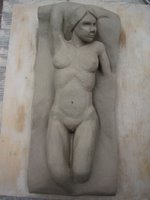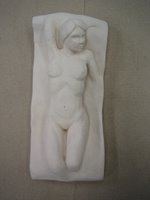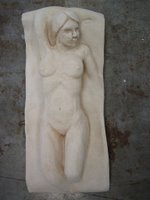(March 2005)
This is the big project. Over the years of taking this coarse there have been several people who have consistently been there. One of them, Gill, always works big. Very big. To heavy to lift big. For a sense of scale his sculptures are topically life size in proportion. By comparison I topically work in a range of 1 to 1.5 feet in length for a full body. This means Gill rarely does the full pose. He usually concentrates on the torso.
I've always admired his work, and decided early in the year I wanted to try doing a pose really big. In the Winter session an opportunity presented itself with a perfect reclining pose. So I grabbed the biggest board I could, a large chunk of Styrofoam to help keep the weight down, a pile of clay, and lots of encouragement from the teacher and tech, and went big.
This sculpture is big, like Gills work. Unlike Gill I tend to be more realistic where he tends to abstract his works. The sculpture is about 80-90 percent life size to the model.
These pictures of the piece are after 3 classes with the model and 1 class of cleaning up. If you look at them in detail you will see the clay is covered in tool marks. This is from me working the surfaces to get the forms just right.
Ultimately I wanted the surfaces to be very smooth. The process of doing this takes a lot of time. It involves working the surface with a fine toothed saw blade and a sponge. Gradually working out all the tool marks and smoothing out the surface. This took another 2 or 3 classes.
These pictures are of the sculpture at the start of the last class I worked on the sculpture. It is fresh out the garbage bags we use to keep the clay from drying out between classes. The next week I started casting it. Almost all of that last class I spent working on the nipples. If you look closely here the nipples are surrounded by a swirl of tool marks. While this look often works, it doesn't work with when the rest of the sculpture is so realistic.
So that class I spent consulting with the teacher and the model that was posing in a different pose at that point, trying to figure out how to make the nipples look more realistic. I settled on a process of adding tiny bumps around the nipple and blending them in. This was a long and slow process but it yielded much better results then what is pictured above.
The other major difference is the rib cage and the clavicle bones have been toned down. The day school teacher dropped in one day, and I know him well from when he used to teach night school, and made a couple of simple comments. He is like that. You don't get praise from him. You do get excellent pointed criticism. Which is exactly the kind of thing you need when learning. He simply pointed out how harsh the lines of the ribs and clavicle were compared to the softness of the rest of the piece. He then left it to me to do what, if anything, I wanted to address it. This is the kind of thing you need when working on something of this nature. You're so close to it it's hard to see it as a whole. Once he mentioned it, I could see exactly what he was saying. So I took steps to soften these lines, and I think it helped a lot.
The next step in this piece is casting it. Unusually I have pictures of some of that process. However I will wait for another post to continue the description.
Wednesday, June 28, 2006
Friday, June 09, 2006
Sculpture: High Fired
(March 2006)
Back to a sculpture from this year. I've posted this one earlier in it's clay form and bisque fired form. Now here it is after it's been high fired.
High firing is as the name suggest done at a much higher temperature. A special kiln is used for high firing. One of the things that happens in high firing is metals within the kiln will vaporize and condense on the pieces. Particularly iron oxides. This gives the pieces a warm glow after the firing. The clay also takes on more of a stone look then the very white crisp look after bisque firing. In this case I washed the piece in an oxide called rutile. This enhanced the natural oxide effect of high firing.
One other thing that occurred during high firing is two cracks formed. This was no surprising, I could see them forming in the bisque fired stage. They also correspond to places where I tried to join to blobs of clay after the clay had dried a little to much to be worked.
The cracks aren't serious, and don't pose a risk of propagating across the piece. They will make it a little weaker if dropped, but I'm not planning to do that intensionally.
Here are the four stages, clay, bisque fired, rutile applied and high fired.
Back to a sculpture from this year. I've posted this one earlier in it's clay form and bisque fired form. Now here it is after it's been high fired.
High firing is as the name suggest done at a much higher temperature. A special kiln is used for high firing. One of the things that happens in high firing is metals within the kiln will vaporize and condense on the pieces. Particularly iron oxides. This gives the pieces a warm glow after the firing. The clay also takes on more of a stone look then the very white crisp look after bisque firing. In this case I washed the piece in an oxide called rutile. This enhanced the natural oxide effect of high firing.
One other thing that occurred during high firing is two cracks formed. This was no surprising, I could see them forming in the bisque fired stage. They also correspond to places where I tried to join to blobs of clay after the clay had dried a little to much to be worked.
The cracks aren't serious, and don't pose a risk of propagating across the piece. They will make it a little weaker if dropped, but I'm not planning to do that intensionally.
Here are the four stages, clay, bisque fired, rutile applied and high fired.
Subscribe to:
Posts (Atom)










